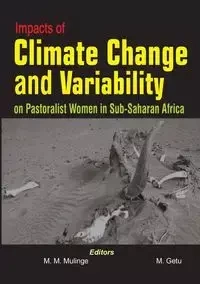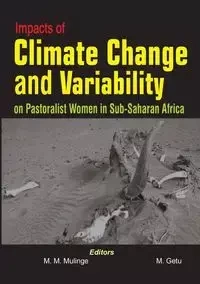Impacts of Climate Change and Variability on Pastoralist Women in Sub-Saharan Africa - Mulinge Munyae M.
Impacts of Climate Change and Variability on Pastoralist Women in Sub-Saharan Africa - Mulinge Munyae M.
EAN: 9789970252367
Symbol
007GJU03527KS
Rok wydania
2013
Elementy
358
Oprawa
Miekka
Format
14.8x21.0cm
Redakcja
Mulinge Munyae M.
Język
angielski

Bez ryzyka
14 dni na łatwy zwrot

Szeroki asortyment
ponad milion pozycji

Niskie ceny i rabaty
nawet do 50% każdego dnia
Niepotwierdzona zakupem
Ocena: /5
Symbol
007GJU03527KS
Kod producenta
9789970252367
Rok wydania
2013
Elementy
358
Oprawa
Miekka
Format
14.8x21.0cm
Redakcja
Mulinge Munyae M.
Język
angielski

The term climate change is used to denote any significant but extended change in the measures of climate. The changes could be due to natural variability or as a result of human activities, such as the burning of fossil fuels to produce energy, deforestation, industrial processes, and some agricultural practices. Such activities release large amounts of carbon dioxide and other greenhouse gases into the atmosphere that hang like a blanket around the earth, thus trapping energy in the atmosphere and causing it to warm up. This results increasingly in climate variability, which is characterised by extreme seasonal, annual, temporal and non-spatial variability in temperature, vagaries of precipitation (rainfall patterns and amounts) and/or wind patterns occurring over a prolonged period of time. The last decade (2001 - 2010) has been the warmest on record; with the average temperatures reaching 0.46∞C, above the 1961 - 1990 mean, and 0.21∞C warmer than the 1991 - 2000 period. It has been proved that the African continent is warming up faster, all year-round, than the global average; a trend that is likely to continue. By the year 2100, it is predicted that temperature changes will fall into ranges of about 1.4∞C to nearly 5.8∞C increase in mean surface temperature compared to 1990, and the mean sea level will rise between 10cm to 90 cm (AMCEN 2011). The interior of semiarid margins of the Sahara and central southern Africa will be the most affected by such warming (AMCEN 2011). To tackle the phenomenon of climate change effectively, human societies have put in place a combination of mitigation and adaptation mechanisms and strategies. Whereas mitigation aims at avoiding or lessening the impacts of the unmanageable, the goal of adaptation is to manage the unavoidable. That men and women are affected differently by climate change suggests that they also differ in terms of the adaptation mechanisms they employ. Despite the existence of gender-based differences in the effects of climate change and in adaptation and coping strategies, studies on the gender differential impacts of climate change and variability on women in general and pastoralist women in particular in sub-Saharan Africa are limited. This volume offers insights and knowledge that pastoralist women developed on climate change adaptation through their experiences in their households and communities and thereby tries to narrow this gap.
EAN: 9789970252367
EAN: 9789970252367
Niepotwierdzona zakupem
Ocena: /5
Zapytaj o produkt
Niepotwierdzona zakupem
Ocena: /5
Napisz swoją opinię

